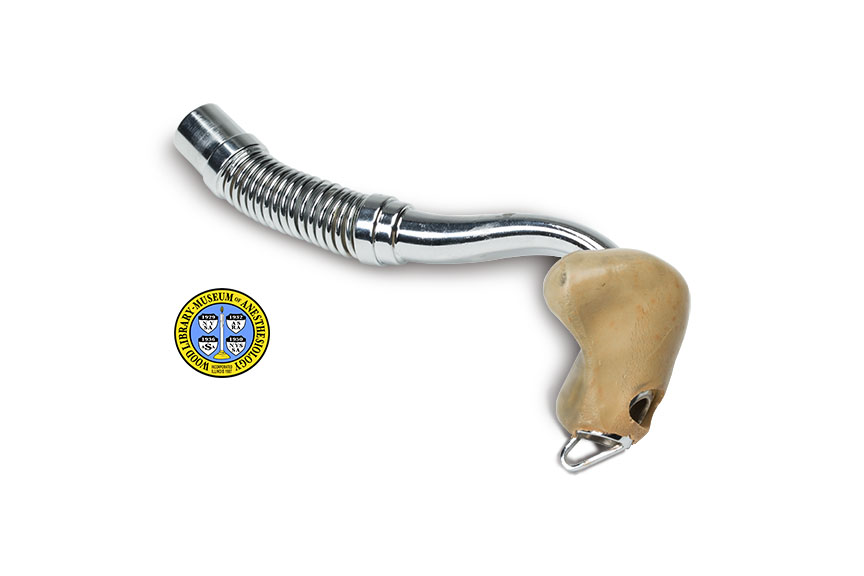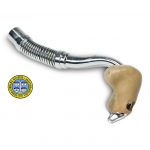Leech Pharyngeal Airway
Canadian anesthesiologist Beverley C. Leech, M.D. (1898-1960), began to design this airway in 1935 for use with the anesthetic gas cyclopropane. Because anesthesiologists did not want any cyclopropane to leak outside of their patients’ airways or breathing systems, the administration of cyclopropane generally required endotracheal anesthesia. This refers to the administration of anesthetic gases through an endotracheal tube (breathing tube) that has been inserted through the mouth, or nose, and into the trachea (windpipe). Since many surgical procedures do not require endotracheal anesthesia, Dr. Leech wanted a new airway: one that was less invasive than an endotracheal tube and yet still sealed the airway.
The shape of Dr. Leech’s soft rubber “bulb” was based on casts that he made from the pharynx of adult cadavers. The pharynx, or ‘lower throat,’ is located just above the opening to the trachea and esophagus (tube to the stomach). Dr. Leech reported that the shape of the bulb fostered a seal to form with the pharyngeal tissues when they relaxed under anesthesia. Anesthetic gas was administered via a metal breathing tube that ran through the bulb. To place the airway, anesthesia was induced and the patient’s tongue was pulled outward while the lubricated bulb was gently inserted through the mouth and into the pharynx. The tongue was then released, which facilitated the formation of a seal.
Catalog Record: Leech Pharyngeal Airway
Access Key: alsu
Accession No.: 1995-03-31-1 CT 1
Title: [The Leech pharyngeal bulb gasway with flexible mouth connector] / [Beverley C. Leech].
Author: Leech, Beverley C. (Charles), 1898-1960.
Title variation: Alt Title
Title: Leech airway.
Title variation: Alt Title
Title: Leech pharyngeal bulb gasway.
Title variation: Alt Title
Title: Leech pharyngeal airway.
Title variation: Alt Title
Title: Leech’s pharyngeal gasway.
Publisher: [Roslyn Heights, New York] : [between 1943 and 1960?]
Physical Descript: 1 airway : metals, rubber, glaze ; 14.5 x 5 x 7 cm.
Subject: Oropharyngeal Airway Devices.
Subject: Airway Management – instrumentation.
Note Type: General
Notes: The early year in the date range for the possible year of manufacture is
based on the earliest Foregger catalog in which the Leech pharyngeal bulb
gasway with flexible mouth connector (metal only) was found (the 1949
catalog). The 1942 catalog has the Leech airway with the longer latex
imbedded flexible connector. The last Foregger catalog in which the Leech
airway was found was the 1960 catalog (number 16). The date range could
change if documentation that indicates the dates should be corrected is
discovered.
Note Type: Not Applicable
Notes: Catalog No. 7. Roslyn, New York: The Foregger Company, Inc.; 1937:65.
Note Type: Citation
Notes: Catalog No. 8. New York: The Foregger Company, Inc.; 1942:76.
Note Type: Citation
Notes: Catalog No. 9. New York: The Foregger Company, Inc.; 1949:75.
Note Type: Citation
Notes: Foregger Apparatus for Anesthesia, Oxygen and Extracorporeal Circulation:
Catalog 16. Rosyln Heights, N.Y.: The Foregger Company, Inc.; ©1960:71.
Note Type: Citation
Notes: Haridas RP. The Leech airway or pharyngeal bulb gasway. Anaesth Intensive
Care. 2011;39(suppl 1)5-10.
Note Type: Citation
Notes: Leech BC. The pharyngeal bulb gasway: a new aid in cyclopropane anesthesia.
Anesth Analg. 1937;16(1):22-25. https://journals.lww.
com/anesthesia-analgesia/Citation/1937/01000/The_Pharyngeal_Bulb_Gasway__A_Ne
_Aid_in.8.aspx. Accessed March 16, 2015.
Note Type: Citation
Notes: Leech BC, inventor. The pharyngeal bulb gasway. US patent 2,099,127. November
16, 1937. https://www.google.com/patents/US2099127. Accessed April 30, 2015.
Note Type: Physical Description
Notes: One airway consisting of metal and rubber; The measurements in the physical
description field are based on the perspective of a patient; Other length and
depth measurements could be obtained measuring the device held at varying
angles; The pharyngeal end is curved and surrounded by a rubber plug or bulb
shaped to fit to and form a seal with the pharynx; The rubber on this example
is tan colored and hardened with age; A metal loop protrudes beyond the
opening at the pharyngeal end; On the posterior side near the pharyngeal
opening is a side opening in both the metal tube and bulb; The mouth end of
the tube is made of flexible metal and a solid connector; There are no
manufacturer marks on the airway; There are some scratches on the metal of
the airway and the rubber is slightly discolored.
Note Type: Reproduction
Notes: Photographed by Mr. Steve Donisch in January of 2015.
Note Type: Acquisition
Notes: Donated to the WLM by the family of Roderick K. Calverley, MD (1938-1995).
Note Type: Historical
Notes: Canadian anesthesiologist Beverley C. Leech, M.D. (1898-1960), began to design this airway in 1935 for use with the anesthetic gas cyclopropane. Because anesthesiologists did not want any cyclopropane to leak outside of their patients’ airways or breathing systems, the administration of cyclopropane generally required endotracheal anesthesia. This refers to the administration of anesthetic gases through an endotracheal tube (breathing tube) that has been inserted through the mouth, or nose, and into the trachea (windpipe). Since many surgical procedures do not require endotracheal anesthesia, Dr. Leech wanted a new airway: one that was less invasive than an endotracheal tube and yet still sealed the airway.
The shape of Dr. Leech’s soft rubber “bulb” was based on casts that he made from the pharynx of adult cadavers. The pharynx, or ‘lower throat,’ is located just above the opening to the trachea and esophagus (tube to the stomach). Dr. Leech reported that the shape of the bulb fostered a seal to form with the pharyngeal tissues when they relaxed under anesthesia. Anesthetic gas was administered via a metal breathing tube that ran through the bulb. To place the airway, anesthesia was induced and the patient’s tongue was pulled outward while the lubricated bulb was gently inserted through the mouth and into the pharynx. The tongue was then released, which facilitated the formation of a seal.
Note Type: Exhibition
Notes: Selected for the WLM website (noted March, 2015).


